Last updated: January 5, 2024
Article
Isle Royale Wolf Relocation
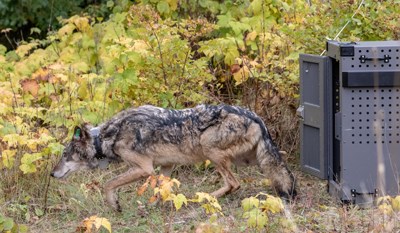
NPS / Jim Peaco
Follow the Tracks of this Wolf
It all happened so fast—the unexpected capture, inspection, relocation. Then the cage door swung open. You caught the first glimpse of a land unknown. Curiously, you exited the cage and stepped further into a wilderness. Becoming familiar with this land filled with places to venture helped you eventually call it home.
You had no idea that your arrival was vital to restoring predator-prey relationships on Isle Royale. Between fall 2018 and fall 2019, nineteen gray wolves experienced similar first steps on the island.
Here is their story of arrival.
Wolf Relocation Project
Record of Decision for Relocation Project
- Extensive planning and consideration of why wolves should be relocated to Isle Royale took place before the Record of Decision was accepted.
- The Record of Decision was signed by Midwest Regional Director of the National Park Service (NPS) on June 7, 2018.
- This signified the beginning of efforts from the NPS and collaborating partnering organizations to relocate gray wolves to Isle Royale National Park.
- Press Release: National Park Service Releases Record of Decision to Introduce Wolves

NPS
Relocation Techniques
Genetically diverse wolves were relocated from Minnesota, Ontario, and Michigan. For all relocation efforts wolves were inspected by veterinarians after capture. Foothold traps, prebaited with nuisance beaver and vehicle killed white-tailed deer carcasses, were used to capture wolves in Minnesota and Michigan. In Ontario, net guns from helicopters were used to capture wolves.
Before each relocation a GPS collar, ear tags, and a passive integrated transponder (PIT) were attached to healthy wolves. Wolves that passed veterinarian inspection were transported to Isle Royale National Park by boat or plane.
Minnesota Grand Portage Band Relocation Effort
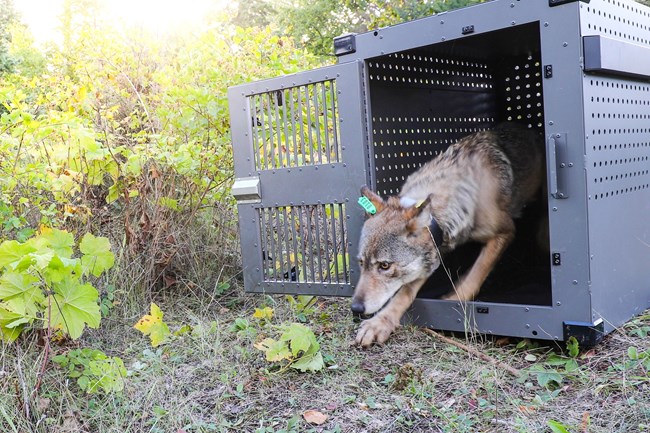
NPS / Jacob Frank
September 24 - October 5, 2018
Wolves were captured in northeastern Minnesota at the Grand Portage Indian Reservation.
Female wolf 002F died soon after capture because of an adverse reaction to anesthetics used for relocation. This wolf's death saddened NPS staff and partners. Even with thorough planning, wildlife relocation can be unpredictable. The NPS is committed to protecting the lives of all wolves involved in the relocation process.
Four wolves, one male (008M) and three females (001F, 003F, and 004F) were relocated to Isle Royale.
Ontario Relocation Efforts
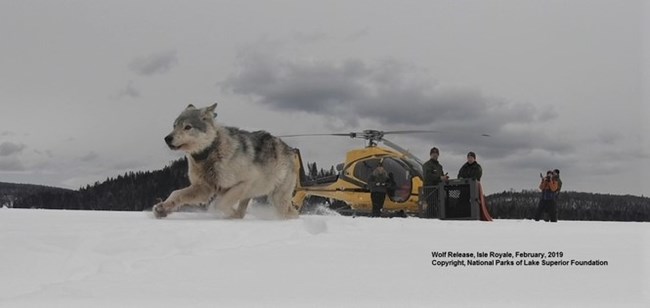
Photo courtesy of National Parks of Lake Superior Foundation
Eleven wolves were captured in Ontario and relocated to Isle Royale.
Female wolf 005F and male wolf 006M were relocated from the mainland near Jostle Lake.
Male wolves 007M and 009M were relocated from Michipicoten Island.
One male wolf was relocated from the mainland near Jostle Lake.
Six wolves were captured from Michipicoten Island and relocated to Isle Royale.
Males: 010M, 012M, 013M, and 016M
Females: 011F, 014F, and 015F
Wolves were relocated from Jostle Lake, Ontario within traditional lands of the Michipicoten First Nation. Jostle Lake is in the Lake Superior Highlands Conservation Reserve managed by the Ontario Ministry of Natural Resources and Forestry (OMNRF).
Three wolves were relocated from the Jostle Lake, Ontario.
Michipicoten Island is found in northeastern Lake Superior about 9.9 miles from mainland Ontario. Most of Michipicoten Island is a provincial park. The remainder of the island consists of private and federal properties.
Wolves, caribou, and beaver inhabited Michipicoten Island between 2015 and 2018. The number of wolves increased while the amount of their prey, caribou and beaver, decreased. The caribou population decreased so much that scientists were concerned about extirpation. Fifteen caribou were then relocated to predator-free islands for conservation purposes. Wolves were then relocated from Michipicoten Island to Isle Royale National Park.
Eight wolves were relocated from Michipicoten Island, Ontario.
Wolf Relocates Itself
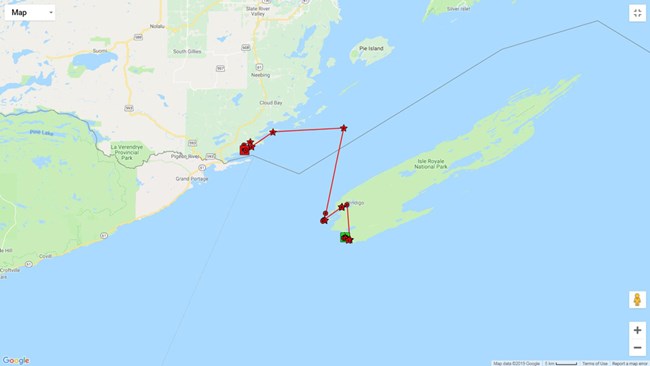
NPS
During winter 2019 a recently relocated wolf left the island. Field scientists researching by plane noticed a wolf’s collar emitting a radio signal from north of Isle Royale. As they approached the island’s northern shore, they realized the signal was emitting from even further north- towards the open waters of Lake Superior. Field researchers hypothesized that a relocated wolf had left the island via an ice bridge that had recently broken up.
Mark Romanski, Isle Royale National Park’s Division Chief for Natural Resources and project lead for the wolf reintroduction efforts, later received GPS coordinates from the wolf’s collar. It was confirmed that the wolf had reached the mainland. The map to the right shows wolf F003’s journey from Isle Royale to the mainland.
Predation, Pack Formation, & Territorial Aggression
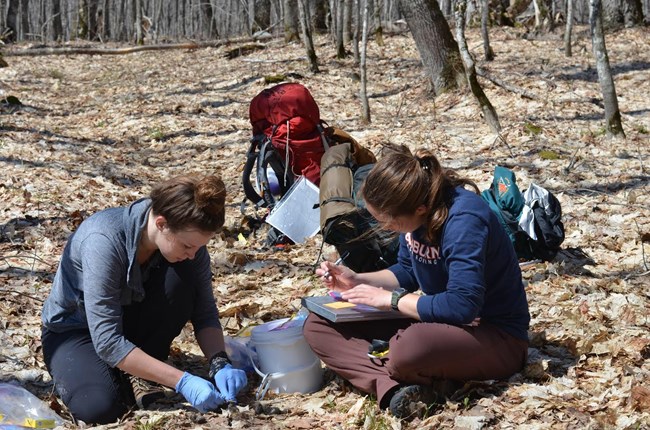
NPS / Tyler Petroelje
May - October, 2019
The NPS and collaborators researched wolf predation, pack formation, and territorial aggression after the majority of wolves were relocated to Isle Royale.
Moose were located at 24 sites (47.1%) determined as probable predation. The majority of moose predation clusters were calves.
Non-moose prey remains were present at 26 sites (52.9%) determined as probable predation events. The non-moose predation clusters included beaver (73.2%), snowshoe hare (11.5%), and other prey. Other prey included red fox kits, bird, and muskrat.
Four cases of wolves killing other wolves (intraspecific mortality) were recorded. This type of conflict is common as wolves defend and establish territories and social hierarchy.
The causes of death of two relocated wolves remain unknown. One wolf died of pneumonia. Another wolf died of cellulitis and suspected septicemia.
Michigan Relocation Efforts

NPS
September 4 - September 14, 2019
Wolves were captured from the western Upper Peninsula of Michigan, including Baraga, Gogebic, Houghton, and Ontonagon counties.
Four wolves, two males (017M, 019M) and two females (018F, 020F) were relocated to Isle Royale.
Researching Wolf Pups
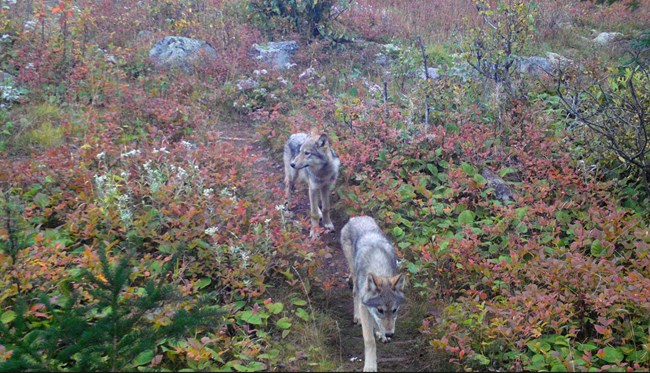
NPS
Tracking the wolf population and reproduction efforts helps evaluate the long-term success of the wolf introduction and the impact wolves have on Isle Royale's ecosystem.
DNA-based evidence from scats collected
GPS collar data
Remote cameras
Acoustic recording units
Information from aerial observations made by researchers at Michigan Technological University
GPS location data suggested wolf 014F denned in 2019 and established several rendezvous sites. On September 29th, 2019 images of two apparent pups were captured on a remote camera. These two wolves are thought to be pups based on their behavior and size.
Researchers will analyze scats collected. If these scats belong to the pups and are genetically related to wolf 014F, that would mean 014F would have bred on Michipicoten Island before being relocated to Isle Royale.
No evidence supports any other reproduction that occurred in 2019.
Data from GPS locations provided by GPS collars on wolves suggested denning activity in early April for wolf 001F. Wolf 001F’s GPS collar attempted to emit a signal in April 2020 but failed- this indicated that the collar was either underground or under thick vegetation.
Some data suggests potential denning activity for wolves 012M and 015F during spring 2020. This potential denning activity has not been confirmed due to collar failures.
Next Steps
Moving forward the NPS and partnering organizations will
- Continue to monitor the wolf population
- Plan for additional relocations of wolves
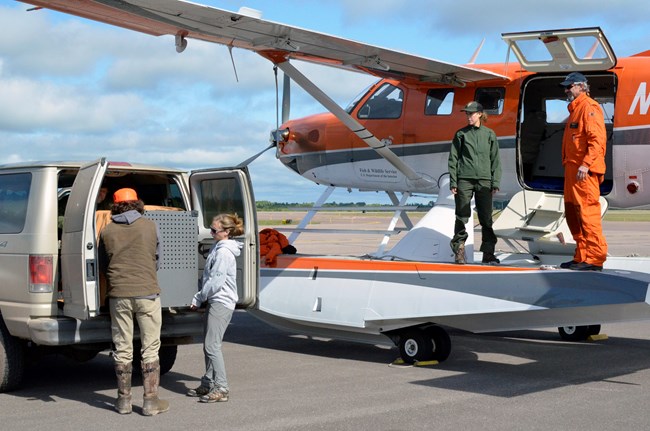
Photo courtesy of Michigan Department of National Resources
Park
Partnerships
The wolf relocation project was possible because of support from a variety of partnering organizations including federal, state, and private groups.
Get to know all of Isle Royale National Park's partners for endeavors beyond this project.
